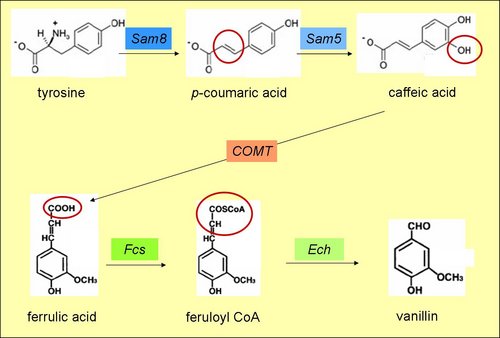Team:KULeuven/Design/Vanillin Production
From 2009.igem.org
Vanillin Production: Design
A vanilla odour is created by synthesizing the molecule Vanillin. The starting point is tyrosine, an amino acid produced endogenously in E.coli. The subsequent pathway involves a combination of five enzymes, biobricked with following codes:
• sam8: : coding sequence without RBS
• sam5: : RBS site + PstI restriction site removed
• COMT: : coding sequence without RBS
• fcs: : RBS + fcs in pSB1A2
• ech: : RBS + ech in pSB1A2
The entire biobrick is placed under a constitutive promoter and .
The first gene sam8 originates from Saccharothrix espeanensis and encodes a tyrosine ammonia lyase. This enzyme catalyses the deamination of tyrosine's amine group and converts tyrosine to p-coumaric acid. sam5 is derived from the same species, but encodes a 4-coumarate 3-hydroxylase which hydroxylates C4 in the aromatic ring of p-coumaric acid. p-Coumaric acid is converted to caffeic acid.
COMT is found in the alfalfa plant and translates to a caffeic acid-O-methyl transferase. After -OH methylation on C4 of the aromatic ring, it produces ferulic acid from caffeic acid. The fourth gene fcs is derived from Pseudomonas fluorescens and encodes feruoyl CoA synthase. This enzyme ligates acetyl-CoA onto ferulic acid and produces feruloyl CoA. ech, another enzyme from the same species, completes the pathway. The gene-product, an enoyl CoA hydratase, cleaves the CoA group from feruloyl CoA thereby converting it to vanillin.
The behaviour of this subsystem should be a production unit of vanillin, which can be regulated by the instantaneous amount of RIBOKEY present in the cell. The production process will be tested in two steps. First, from tyrosine to ferulic acid; then from ferulic acid to vanillin. E. coli controls its own tyrosine production which is a non essential amino acid. However, should this be insufficient, we can always add extra tyrosine.
By locking both the transcription of the sam8 and COMT enzyme we prevent vanillin synthesis without the presence of the RIBOKEY. Because we want the production of vanillin proportional to the amount of input key, it is essential that the regulated enzymes, that catalyse the production of (intracellular) vanillin, degrade as fast as possible. As proteins are normally very stable in the intracellular environment, sam8 and COMT where labelled with a LVA-tag, which insures relatively fast half times. Due to the non zero half life time of the regulating enzymes, the production depends on the integrated amount of RIBOKEY over several half lives.
 "
"









